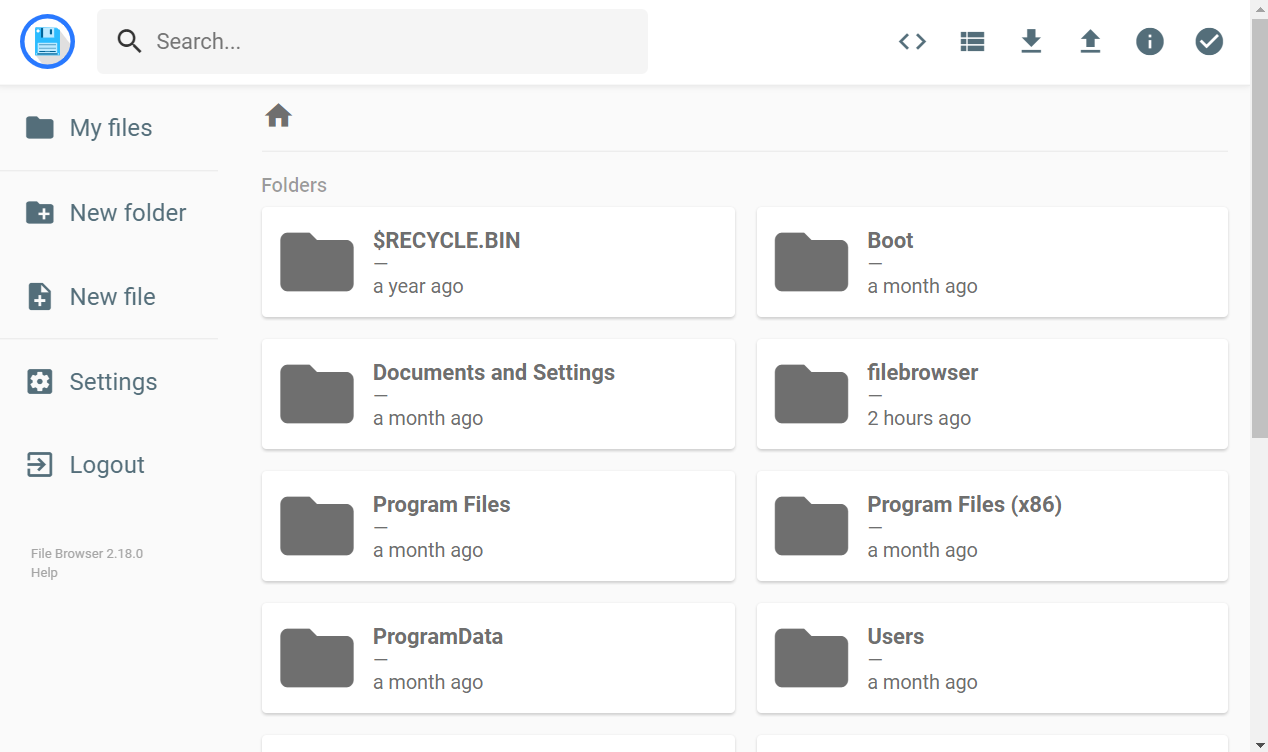Exploring files from a Windows container host through Filebrowser
Having a web-based file explorer functionality for a Windows-Server-base container host is a surprisingly difficult task. In our COSMO Azure DevOps & Docker Self-Service, we always include an Azure File Share for - surprise - sharing files, but while it offers perfect functionality for our needs, it isn’t exactly end-user friendly. Therefore, I searched for an easy-to-use alternative, allowing our end-users to have an explorer-like functionality through a web client. Everything in that environment is containerized and on Windows Server hosts, and to my surprise I didn’t find anything that worked straight-up on Windows. If ignored my Windows requirement, the one option that came up very often in searches and also was suggested by Portainer’s Neil Cresswell was Filebrowser. It didn’t have a Windows container image, but fortunately, that turned out to be very easy to create.
The TL;DR
If you want to use it for yourself, you can just run
docker run -e "FB_ROOT=c:\" tobiasfenster/filebrowser-windows:v2.18.0
After that, you can access [http://localhost:8080], log in with the default user / password combination of admin / admin, and you can start using Filebrowser!

As you have probably guessed, the FB_ROOT=... environment variable defines which folder is the root folder for Filebrowser. E.g. if I wanted to explore only my home folder, I would run
docker run -e "FB_ROOT=c:\users\tfenster8982" tobiasfenster/filebrowser-windows:v2.18.0
The Details: The container image, setting the default password and other configurations
As I already mentioned, there wasn’t a Windows container image for Filebrowser, so I created one. If you are interested, you can find the sources here. The only interesting part in that repo is the Dockerfile and even that hast only a few interesting lines:
1
2
3
4
5
6
7
8
RUN Write-Host "Downloading and expanding $($env:VERSION)"; `
$url = ('https://github.com/filebrowser/filebrowser/releases/download/' + $env:VERSION + '/windows-amd64-filebrowser.zip'); `
New-Item -ItemType Directory -Path 'c:\filebrowser' | Out-Null ; `
Invoke-WebRequest -UseBasicParsing -Uri $url -OutFile 'c:\filebrowser.zip'; `
Expand-Archive 'c:\filebrowser.zip' 'c:\filebrowser'; `
Remove-Item 'c:\filebrowser.zip';
ENTRYPOINT [ "c:\\filebrowser\\filebrowser.exe" ]
You can see in line 2 the definition of the download URL for a zip file of a specific version of Filebrowser. Then in lines 3-5 a new folder is created, the zip file is downloaded and expanded into the new folder. As a last step in line 6, the zip file is removed as we don’t need it in the image.
Line 8 shows you how Filebrowser is started, using the ENTRYPOINT directive, pointing at the filebrowser.exe file. Setting it up in this way instead of the CMD directive allows you to use another nice feature of the Filebrowser image: You can generate the (bcrypt) hash of a password you want to use by running
docker run tobiasfenster/filebrowser-windows:v2.18.0 hash Super5ecret!
This returns the hash, in my case $2a$10$Icqg9QIqjuQqwDrQvhuLhOo8j7CA5sUNGglms6otq7lFYu8o3EMVy. With that, you can now improve the docker run command above to not set the default password, but instead your own. To do that, you run the following
docker run -e "FB_ROOT=c:\" -e 'FB_PASSWORD=$2a$10$Icqg9QIqjuQqwDrQvhuLhOo8j7CA5sUNGglms6otq7lFYu8o3EMVy' tobiasfenster/filebrowser-windows:v2.18.0
As your hash will contain $ signs, make sure to use single quotes ' for the FB_PASSWORD env variable or escape the $ as `$ as powershell will otherwise try to resolve it has variable.
The Details: More configuration options
There are a couple of options in Filebrowser, similar to the root and password configuration you have seen above. All of them are documented here (note that setting the options as env parameters works by upper casing and prefixing with FB_, so e.g. the option root becomes FB_ROOT), but I want to give you our scenario as an example:
- We are defining the service as stack, using the compose file format
- We run Filebrowser behind Traefik, so we need to add a couple of labels (lines 17-22 below) for that and let Filebrowser know that it runs as
/filebrowserby settingFB_BASEURL=c:\azurefileshare(line 26) - As I wrote above, we want to use Filebrowser to explore an Azure File Share, which is available as
s:\on the host, so we need to map this as bind mount (lines 7-9) and set the mapped path asFB_ROOTby settingFB_ROOT=c:\azurefileshare(line 25) - Filebrowser needs to listen to requests coming in through Traefik, so we are opening it up for all IPs by setting
FB_ADDRESS=0.0.0.0(line 24) - As seen above, we also set the default password (line 27)
Overall, the stack definition looks like this:
1
2
3
4
5
6
7
8
9
10
11
12
13
14
15
16
17
18
19
20
21
22
23
24
25
26
27
28
29
30
31
version: "3.7"
services:
filebrowser:
image: tobiasfenster/filebrowser-windows:v2.18.0
volumes:
- source: s:\
target: C:\azurefileshare
type: bind
networks:
- traefik-public
deploy:
placement:
constraints:
- node.role != manager
labels:
- traefik.enable=true
- traefik.http.routers.filebrowser.rule=Host(`${BASE_URL}`) && (PathPrefix(`/filebrowser`))
- traefik.http.routers.filebrowser.entrypoints=websecure
- traefik.http.routers.filebrowser.tls.certresolver=myresolver
- traefik.http.services.filebrowser.loadBalancer.server.scheme=http
- traefik.http.services.filebrowser.loadBalancer.server.port=8080
environment:
- FB_ADDRESS=0.0.0.0
- FB_ROOT=c:\azurefileshare
- FB_BASEURL=/filebrowser
- FB_PASSWORD=${PASSWORD}
networks:
traefik-public:
external: true
Because of the great stack support in Portainer, which we are using to manage our environments, we can easily define and deploy everything:

I hope this gives you a good starting point with Filebrowser and allows you to run it on your Windows-based container hosts.
Webmentions:
Likes:
.png)